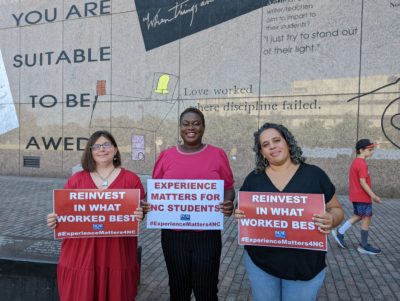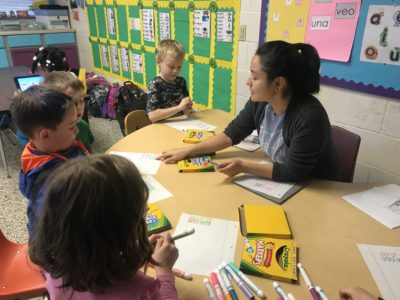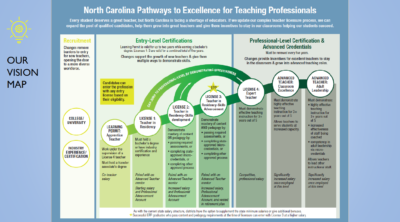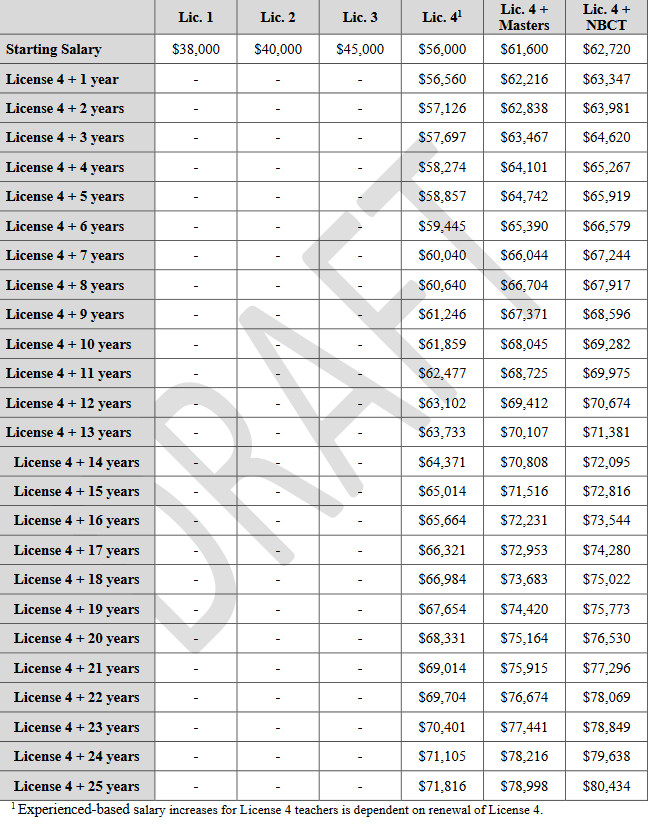
|
|
The Professional Educator Preparation and Standards Commission (PEPSC) considered an updated draft of a proposal to change how North Carolina teachers are licensed and compensated on Thursday.
This proposal would overhaul North Carolina’s teacher licensure system by introducing levels of licensure and corresponding pay.
Read more about the draft plan



PEPSC’s four subcommittees — Preparation and Entry, Licensure, Advancement and Development, and Budget and Compensation — have been working on this model for the last year. The subcommittees have also been considering feedback from the public. PEPSC Chairperson and UNCW College of Education Dean Van Dempsey said all of this work has been synthesized into the model presented this week.
You can see this updated proposal below. Phrases that have a strike-through have been removed from the proposal, while those in orange have been added or edited.
You can also see an updated proposed salary schedule below. License IV is where PEPSC predicts the majority of current teachers would fall.
These numbers are the base salary, which does not include any local supplements or raises passed by the state legislature.

Sign up for the EdWeekly, a Friday roundup of the most important education news of the week.
What’s different?
Under this model, teachers would have to demonstrate effectiveness through a certain set of criteria to advance through licenses and achieve a higher pay. The bulk of the changes to the model concern what those criteria could be.
The model now broadens what tools can be used to measure effectiveness, eliminating references to the qualitative growth review and Practical Educator Evidence Review (though it maintains some of the components). The commission also added a provision that says additional tools can be developed in the future.
It also provides alternatives to using EVAAS as a measure, which has been a point of contention.
There’s also one big addition. For License IV teachers, National Board Certification would also be an option to qualify for renewal. PEPSC member and Dr. Jo Watts Williams Dean of Education at Elon University Ann Bullock suggested that the commission consider a master’s degree as an option for renewal as well.
The other biggest change is to the pay component.
The model now includes a recommendation that master’s pay be reinstated. The salary schedule already included a provision that would maintain it for those who were grandfathered in when the law changed in 2013, but this would expand it to teachers who have earned a master’s since and going forward.
This updated draft also adjusts how teachers would earn raises. In the original proposal, teachers would have earned an additional $5,000 at the time of renewal. Under the new proposal, teachers would earn a 1% yearly increase contingent on successful licensure renewal every five years.
“I could contend that these (salary numbers) are still not high enough, but certainly a significant improvement over what we’re dealing with at the present time,” said Sam Houston, PEPSC member and president of the North Carolina Science, Mathematics, and Technology Education Center. “And then we’ll probably get to a point sometime when this thing goes to the General Assembly, the debate will be, we can’t afford it. Which we all know is not true. There’s plenty of money in the budget to afford issues of this type. It’s just whether or not we want to spend it for those purposes.”
These are just PEPSC’s recommendations, and there’s still a long way to go before this would be implemented. This proposal still has to be approved by the State Board of Education and then go through the state legislature for approval, and it could change along the way.
Considering feedback
The draft proposal was a discussion item at Thursday’s meeting, meaning no action was taken. The original timeline was for PEPSC to send a final draft to the State Board of Education this fall for approval, but Dempsey signaled that the commission could take longer if it needs to.
He acknowledged that several commission members asked questions that will need to be addressed.
“If at the October meeting, we were at a point where we had that kind of clarity, we could take action at that meeting,” Dempsey said. “That is not a requirement that we do it in October. We want to be deliberate about making sure the document is clear, but we also want to be respectful of the State Board’s interest in us getting the recommendations to them in a timely manner.”
At the end of the meeting, Bullock asked if there would be a systematic review of all the feedback from stakeholders that PEPSC has received during this process.
Dempsey said he has reviewed every email and document he received, which several other members echoed in the meeting’s chat.
“Many of the questions that I’ve seen in the emails or the concerns that I’ve seen in the emails are now in draft language in the document,” he said.
Connie Locklear, PEPSC member and director of the Indian Resource Center at Public Schools of Robeson County, asked if it’s clear to the public that this draft isn’t a merit pay proposal.
“In my mind as the chair, in the traditional sense of how we have used the term merit pay, I do not think it is a merit pay model,” Dempsey responded.
Locklear said many individuals in the field are concerned because they consider the proposal merit pay.
“I think we came to this work, and the goal was to put individuals in the classroom that had trouble with passing the PRAXIS, passing the test,” she said. “I think that we’re clear on our end, but I’m asking, are we putting information out there to ensure to the public and adding clarity to that point?”
State Superintendent Catherine Truitt said the challenge for her in responding to feedback is that the majority of it is grounded in a misunderstanding of the model.
She said the commission heard a definition a few weeks ago that merit pay in the private sector “is when pay is given out in competition with one another.”
“This pay proposal is in competition with oneself, or you are being measured against yourself, not someone else,” she said.
This is a different definition of merit pay than what was used at a State Board meeting earlier this year where the proposal was discussed. At that meeting, Truitt defined merit pay as pay for performance.
PEPSC member and 2020 Teacher of the Year Maureen Stover added on to say that the purpose of this model is to improve educational outcomes for students.
“As a practitioner, the way I know how to best meet the diverse needs of every single learner in my classroom is by knowing exactly where they are in their learning, and then designing instruction around what they need to get to where they need to be,” she said. “We do have effectiveness tools that are being developed as part of this model. But those effectiveness tools are tools that will enable practitioners to know where their students are.”
PEPSC plans to continue work on the model at its October meeting. You can send feedback to pathways.feedback@dpi.nc.gov.
“This is important, potentially transformative work for children, educators, schools, and communities in North Carolina, and I fundamentally believe that,” Dempsey said. “I cannot think of a group of people who can bring more experience, expertise, wisdom, and integrity to the charge that is before us than PEPSC.”
Recommended reading




